Reclined Big Toe Pose A or Supta Padangusthasana A in Sanskrit (‘supta’ = ‘supine or recline’, ‘pada’ = ‘foot’, ‘angustha’ = ‘big toe’ and ‘asana’ = ‘ posture’) is a simple pose, that is practiced while lying down on the back bringing in one leg raised up at 90-degrees while the other leg remains stretched out on the floor. The raised leg is held at the big toes by the hand on the same side and the hand should be perpendicular to the floor in this practice, and hence the name Reclining Big Toe Pose. Its other names are Reclined Hand To Big Toe Pose or Reclining Hand-to-Big-Toe Pose. This pose is beneficial for people who spend a lot of time sitting or standing, as it helps to release tension in the legs and lower back. It also helps to improve balance and stability, as well as to stretch the muscles around the knees and ankles. In addition to the physical benefits, Supta Padangusthasana can also help to calm the mind and relieve stress. By focusing on your breath and body during the pose, you can cultivate a sense of inner peace and relaxation. In general, Supta Padangusthasana is a great pose for improving core muscle strength, bringing in fresh blood towards the hips and thus also improving flexibility at the hips and lower back. Supta Padangusthasana A is considered a base pose as Supta Padangusthasana a variations can be derived from this pose.
Beginners Yoga For Flexibility And Tone
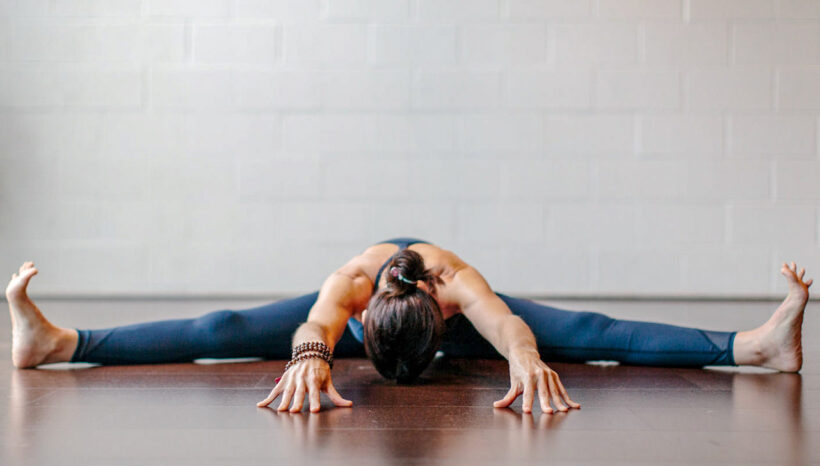
When many of us think of yoga, we automatically think of the breathing and meditation aspects of yoga. However, yoga is one of the best forms of exercise to tone your entire body with many poses also focusing on creating flexibility by creating longer muscles.
Beginners yoga for flexibility will not only improve your muscle quality but also strengthen muscles to avoid niggling pains. In the following article, we will have a deeper look at how yoga can benefit beginners looking to tone their bodies and improve overall flexibility. Improved flexibility can help you avoid muscle strains while ensuring that muscles are always stretched. Now, you can avoid potential injuries, which lead to long-term issues.
Benefits Of Yoga For Strength Training And Flexibility
One of the biggest benefits of yoga is to improve the overall strength of the body and promote a better lifestyle. Since it is primarily designed to improve your lifestyle, you will notice a healthier you, which leads to more positive effects during the day. However, yoga has a lot of benefits for strength and flexibility, as you can see here.
- Improving Body Flexibility. Being flexible can help reduce stubborn injuries from doing everyday tasks, while also releasing endorphins that lead to a positive mindset. Since there are not many activities we do daily to improve flexibility, yoga can be handy in loosening up those muscles. You don’t need to perform hours of yoga and some of the effects are almost instantaneous. Studies have shown that people doing yoga daily can find an increase in flexibility in the first eight weeks of starting. With a 35% increase in flexibility, you have more activities that you can do and your levels of resistance will also be increased significantly.
- Improved Hip Hinge Movement. Let’s face it, almost any activity that involves you moving will require that you need to move your hips. As we grow older, the hips tighten, making it harder to perform certain activities and also lead to more risks. Yoga can loosen the hip flexors to ensure that you avoid these potential injuries for longer in life. Many yoga exercises will also strengthen hip muscles to avoid potential pain.
- Overall Strength Gain. You don’t need to spend hours in the gym lifting weights to improve the strength of your muscles. Since yoga poses will put a lot of strain on the muscles, they will inevitably be forced to deal with the tension. The more the muscles work, the stronger they will become, leading to better strength that allows you to perform daily activities.
- Promoting Good Posture. You might have taken a stroll through a mall or any public area and noticed the way many people slouch forward when walking. The forward slump is often caused by sitting at a desk and working all day without strengthening the back muscles. Fortunately, yoga targets the back and abdomen muscles in such a way that you will be comfortable walking with an upright posture. All of this will snowball, leading to strength increases in all muscles around the hips and abdomen.
- Improved Breathing. If you spend some time in the gym, one of the first things that any expert will mention is your breathing. When lifting weight, it is important to inhale as you put tension on the muscle and exhale as you release the tension. Breathing is something you need to work on and since one of the focuses of yoga is breathing; you can do this much faster. For your next strength training session, you will notice your breathing significantly improved.
- Mental Health Improvements. There are many studies the suggest how yoga can improve your mental health. Nowadays, depression is one of the leading causes of people just giving up in life. However, yoga promotes a healthy lifestyle and releases dopamine. The combination of dopamine and serotonin can create a positive mindset, leading to an optimistic outlook on life.
Best Yoga Workout For Flexibility For Beginners
As a beginner, it can be intimidating when you don’t know where to get started. However, there are a few basic yoga routines that almost anyone can perform. While we will discuss the specific poses that work best for beginners, the following routine could be best-suited for beginners looking to start their first week of yoga.
| Day | Yoga Workout | Time |
|---|---|---|
| Monday | Breathing Exercises (Pranayama) | 20-minutes, twice a day |
| Tuesday | Full Body Stretch | 30-minutes (morning) |
| Wednesday | Active Vinyasa | 30-minutes (afternoon) |
| Thursday | Full Body Stretch | 30-minutes (morning) |
| Friday | Rest Day | Rest Day |
| Saturday | Breathing Exercises (Pranayama) | 20-minutes, twice a day |
| Sunday | Rest Day | Rest Day |
While this is a simplified guide for beginners to get into yoga with breathing and strength training combined, you will eventually need to scale up your workouts as your body becomes accustomed to the routines. The more you can stick to this schedule and follow a healthy diet, the better your results will be in the long term.
Sivananda Yoga is one of the best forms of yoga that one can start with as a beginner. It combines most of the basic poses you will see in the following section while adding various forms of breathing exercises. Sivananda Yoga does not completely tire out your body but can be combined with Vinyasa for a full-body workout.
Yoga Poses For Flexibility And Strength For Beginners
With some basic knowledge about specific workout routines, you might also want to know which yoga poses are the best for flexibility and strength. We have isolated a couple of the top yoga poses that could help you with strength and flexibility while improving your overall mindset. The following yoga poses are what we recommend to all beginners:
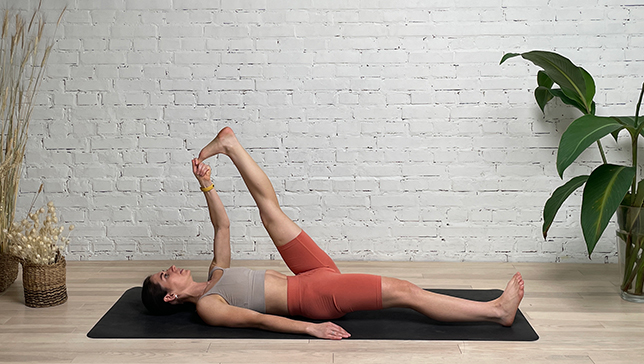
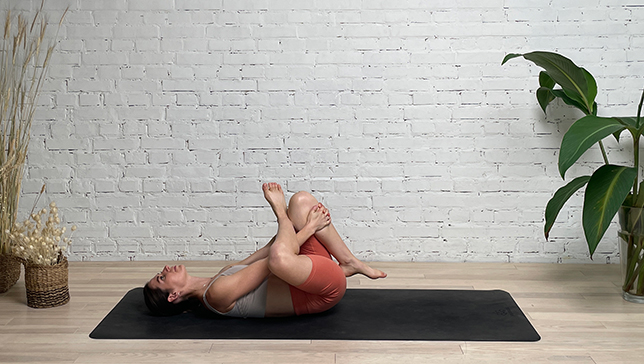
Reverse Pigeon Pose Yoga or Sucirandhrasana in Sanskrit is an elegant combination of a gentle hip-opener and an effective hamstring stretch. Also known as the Eye of the Needle Pose it is commonly used by runners during recovery, to release any strain in the hamstrings and glutes. Typically Sucirandhrasana is practiced at the end of a yoga sequence to cool down the muscles of the hips, legs, and lower back. This supine pose is a grounding practice and works on the connecting tissues when held longer, hence should be included in Yin Yoga for better flow of energy through the channels, and to activate certain meridians.
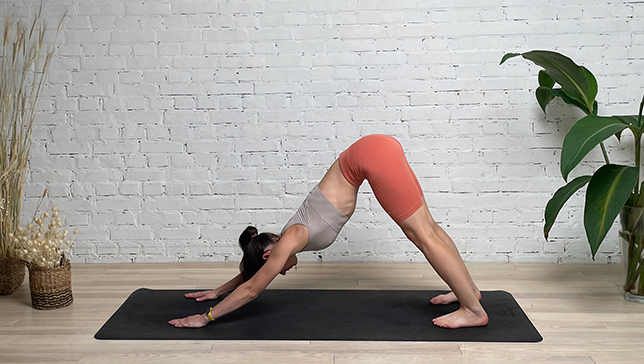
Downward Facing Dog Pose or Adho Mukha Svanasana in Sanskrit (Adho means 'downwards', Mukha 'face', and Svana means 'dog') is a foundational yoga pose that is often used as a transitional pose between other yoga asanas. Downward Facing Dog position provides a great stretch and strengthens the entire body, especially the arms, shoulders, hamstrings, calves, and spine. It can also help to calm the mind and relieve stress. Adho Mukha Svanasana is considered a base pose as Downward Facing Dog Pose Variations can be derived from this pose. This is a great pose to boost energy in the body and hence can be included in flow yoga sequences.
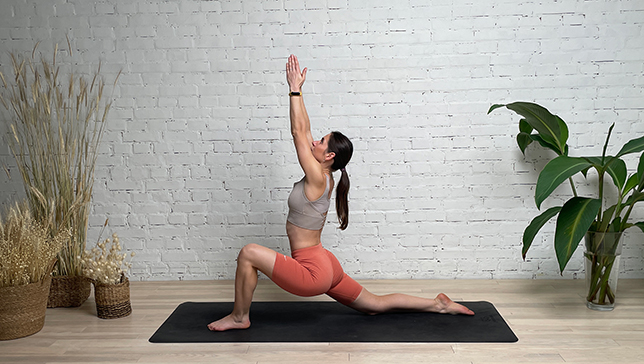
Crescent Low Lunge Pose or Anjaneyasana gets its name after Lord Hanuman's mother named Anjani. Another name for Hanuman in the Hindu culture is ‘Anjaneya’. Lord Hanuman is referred to as the mighty God with boundless power and strength, and this pose brings in the same kind of power and strength when practiced the right way. This standing hip opener and heart opener pose is sometimes also known as the Crescent Moon Pose because of how the body looks.
Anjaneyasana is performed by stretching one leg behind and placing the other one in front with the knee bent and the foot on the floor. The arms are raised up with palms joined in Namaste and expanding the chest and stretching the neck.
Anjaneyasana is a deep stretch for the hip flexors and quadriceps. It can also be a little bit of a backbend if you want it to be. Crescent Low Lunge Pose is also called Low Lunge Pose, it's the first and simple version of the Crescent High Lunge Pose. The low Lunge Pose is considered a base pose as low lunge pose variations can be derived from this pose. Low Lunge Pose helps boost energy in the body and hence can be included in flow yoga sequences.
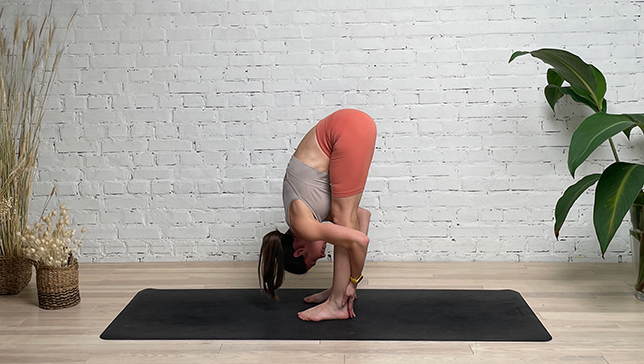
In Standing Forward Bend Pose or Uttanasana in Sanskrit (‘Ut’, means 'intensity' and the ‘Tan’, means 'stretch, extend or lengthen out') the spine is given a deliberate and intense stretch. This yoga pose consists of standing with feet together, bending the upper body at the hips and letting the head hang downwards, and taking control of the body by placing the palms on the floor beside the feet.
This intense forward stretch of the upper body including the spine brings an indirect opening of the hamstring muscles. Standing Forward Bend Pose is considered a base pose as standing forward bend pose variations can be derived from this pose. Standing Forward Bend Pose helps boost energy in the body and hence can be included in flow yoga sequences.
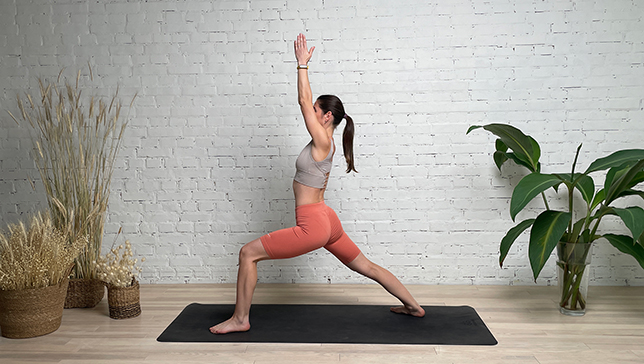
As per Hindu Mythology, ‘ Virabhadra’, was the name of a ‘Warrior’, created by Lord Shiva. Hence this pose comes from the creation of the fiercest warrior by Lord Shiva and so the name goes as ‘Virabhadrasana’ or ‘Warrior’ Pose. In Sanskrit ‘Vira’ means ‘Hero’ ‘Warrior’ ‘Vigorous’ and ‘Courageous’, and ‘Bhadra’ means ‘good’ ‘auspicious’.
Considered to be a powerful posture replicating the power of a warrior, this pose is the first variation amongst the many under warrior poses. The importance of practicing this pose is emphasised clearly in all schools of yoga as it forms a part of the standing poses which includes balance, stability and stamina. To balance the body with feet more than hip distance apart and raising the arms above your head while gazing at them, requires one to connect the body with the breath. Practicing the alignment of the feet and the knees, along with the torso marks as a great pose to add beauty to one’s body.
Warrior Pose I is considered a base pose as Warrior Pose I variations can be derived from this pose. Warrior Pose I helps boost energy in the body and hence can be included in different yoga sequences.
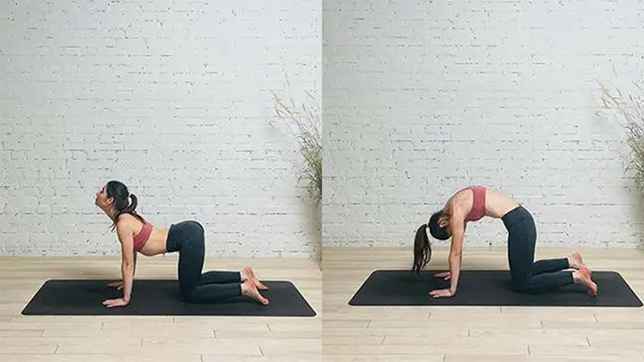
Cat-Cow Pose or Marjaryasana-Bitilasana in Sanskrit ( ‘marjari’ meaning ‘cat’, ‘bitila’ meaning ‘cow’, and 'asana' means 'pose') is a combination of two poses practiced together to gently warm up the spine and the abdomen for more challenging postures or is sometimes also practiced as a simple restorative pose. Coming on all fours, gently moving the back in a rhythmic way, and taking the position like that of a cat or a cow, releases the tensions around the spine and shoulders and tightens the abdomen to make a stronger core. Cat Cow Pose is considered a base pose as Cat-Cow Pose variations can be derived from this pose. Cat-Cow Pose helps boost energy in the body and hence can be included in different yoga sequences. Cat-Cow Pose is considered a warm-up yoga pose to prepare the body for more intense yoga poses or flows.
Wrap-Up
If you want to perform yoga for flexibility for beginners, the above-mentioned asanas and routines would be ideal to get you started. It might take some time to achieve the desired results, but yoga has always been a great way to strengthen muscles. BY strengthening your muscles and improving your flexibility, you could have a much happier life.
Frequently Asked Questions
Since yoga targets the smaller and larger muscle groups in your body, it has the potential to help with flexibility. While you might not have immediate flexibility, you will eventually gain flexibility by sticking to a schedule.
While almost any form of yoga is great for strength and flexibility, the combination of Power Yoga and Sivananda Yoga can be very effective. Power yoga might be more daunting but will increase muscle strength more rapidly.
The logical answer is that it will depend on your body and composition. However, many studies have suggested that it takes up to eight weeks to improve flexibility. Many people have suggested that you can see improvement in flexibility in the first four weeks.
Yes, regardless of your age, one can become flexible. It might take some time to regain flexibility when you are older, but every person can regain flexibility regardless of their age. It only takes the right motivation and dedication to get started.



